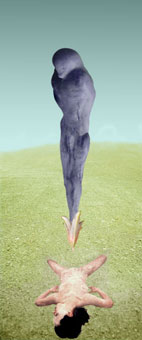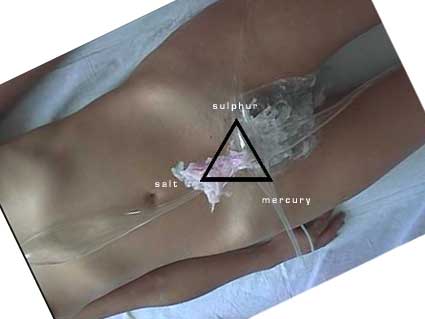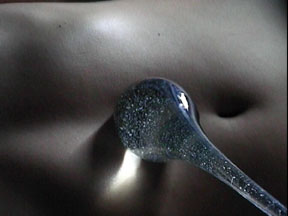description | the role of the Chorus | the elements | thesmophoria | the music | the performers
video stills
timetable of the work
bio-performance theory introduction
The Garden
"Man is not intelligent.Only what sourrounds him is intelligent."
(Heraclitus from Ephesos, 148)
According to Heraclitus we become intelligent by drawing in this divine reason [logos] through breathing, and forgetful when asleep, but we regain our senses when we wake up again. For in sleep, when the channels of perception are shut, our mind is sundered from its kinship with the surrounding, and breathing is the only point of attachment to be preserved, like a kind of root; being sundered, our mind casts off its former power of memory. But in the waking state it again peeps out through the channels of perception as though through a kind of window, and meeting with the surrounding it puts on its power of reason.Sextus adv. Math. VII, 129.
God becomes man becomes fish becomes barnacle goose becomes featherbed mountain. Dead breaths I living breathe, tread dead dust, devour a urinous offal from all dead. James Joyce, "Ulysses".
the concept:
a performance for a male performer, 3 women performers, a female chorus, (with references to Thesmophoria , a celebration of Sporetos ,"Seed-time", the autumn sowing,
dedicated to Demeter and restricted to women.)
using hidden technological apparatus through which space becomes a field of interaction: a thermal camera,
electrodes connected to an electric valve, computers, miniDV cameras, loudspeakers
simulation still- large scale
Description:
the ground consists of sulphuric yellowish soil; the male performer is made up like a pan[1] rather than a satyr, a cross-species creature in blue skin (newborn animal-bird with extended legs). He uses hidden electrodes to activate an electrovalve mechanism for letting mercury enter the glass triangle and mix with saliva. The male performers' transformed genitalia recalls the androgyny of Dionysos, when young men carrying brances were dressed as women.
the glass tears of the male performer who occasionally takes the role of Demeter are remniscent of Demeter, the mother of Kore who grieved great tears for the loss of her daughter and searched the world leaving the fields fruitless and barren(that's why the ground in the performance is sulphuric)
the first female performer appears to be slightly mutated. She lies on the sulphuric ground. On her body She spits saliva which moves to the central part
of the glass sculpture to mix with mercury and drips on the sulphuric ground.
the second and the third female performers hide the organic-like silicone sculptures in the ground
the thyrsus acts as musical instrument: the male performer gets periodically the thyrsus[2] (a pole carried by Dionysus, and by Satyrs, Maenades, and others who engaged in Bacchic festivities and rites) and scans the performance space; a hidden thermal camera is concealed inside the thyrsus. The thermal camera measures the temperature of the female performer and the space
all temperature changes are transmitted to the computer which produces a real-time "foreground" synthesis, in contrast to the female chorus synthesis the female chorus consists of seven sopranos which perform a music synthesis based on abuse
The shamans' thyrsus is constructed in accordance to the scourge made of morotton or thyrsus,(woven bark) which was used from participants whipping each other at the 'Thesmophoria'. This celebration of autumn sowing was dedicated to Demeter and restricted to women in ancient Greece. The women also engaged in Aiskhrologia (Foul language. abuse), hurling insults at one another to commemorate the way in which Iambe made the grieving Demeter laugh.
glass sculptures schematised in the form of tears, host colonies of the transgenic flies.
duration of the performance might be 2 - 3 days as a continuous event (see below: During the Thesmophoria proper the women
camp for three days in the Thesmophorion, the hillside sanctuary of Demeter Thesmophoros)
All performers look neither male or female, with their genitals covered up by silicone skin.
3 women lay on the sulphuric ground. They also appear slightly mutated with the aid of silicone extensions. They occasionally
carry flesh-like sculptures made of silicone which they hide under the ground.
the performance lasts with a "miisis"(=induction)of the third woman which takes a kneeling stance, with the two other women holding her from the arms, while forming with raw silicone
an extract on her forehead. This stance recalls the death of Pentheus, are torn to pieces by Theban women because he did not allow the worship of Dionysos. In this performance, the silicone extracts are a reversal of this dismemberment.
Mythology also associates the maenads with other unconventional behaviour, including eating the raw flesh (omophagia) of their victims, but it is unlikely that this was taken literally (or replicated) among actual initiates. [3]
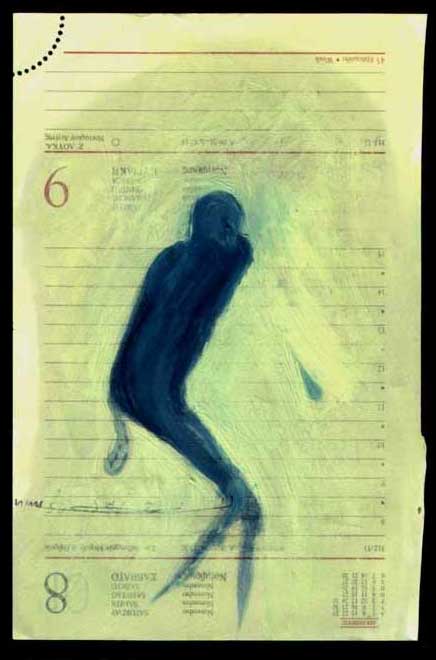 |
drawing (above) and synthetic clay sculpture (below) of the male performer
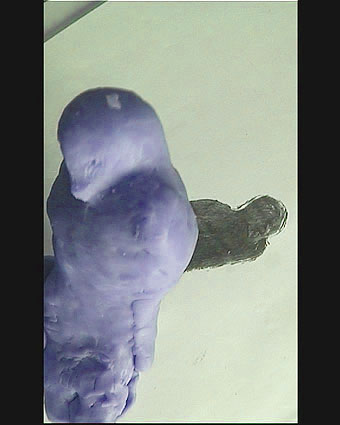 |
|
maquet from synthetic clay
thermal images of a female body
a small thermal camera is hidden inside the thyrsus |

the glass sculpture where mercury mixes with saliva and drips on the sulphuric ground
 |
||
|
|
||
 |
|
|
||
|
The male performer throws blown glass sculptures which shatter on the sulphuric ground; they are formed like tears to correlate with toxic vomit of the bird Blue jay |
||
|
The monarch butterfly "Danaus" is mimed by the viceroy "Umentis archippus". While the monarch butterfly is distasteful to birds, the viceroy is edible."Predators that eat the butterflies usually vomit .Once having eaten a monarch, however, the jays avoid both monarchs and viceroys." |
||
|
Blue jay eating a toxic monarch butterfly and then vomiting. (Photograph: Lincoln Brower) David McFarland, Animal Behaviour, Third Edition, Longman editions.1985, page 91 |
Notes and references
1. '...Zeus and Apollo are often named as the father of Pan, but Hermes (Mercury) had the best claim...In Greek mythology, Pan was a familiar of herdsmen and nymphs, he haunted the upland pastures and the shadowy places of siesta and his music was that of the countrymen...For his mother we hear of the nymph Penelope, who could get confused with the wife of Odysseus and even give rise to the story- by the fact that the Greek word pan means 'all' -that he was fathered by the conbined attentions of all her suitors. However, his name does not derive from the Greek pan, but comes from the root pa~, a contracted form of pa~on meaning herdsman...Although Pan came to be confused with satyrs in antiquity as he did in Renaissance, there was a basic difference, because the satyrs start as essentially human, and acquire animal features in varying degrees as time passes, while Pan starts as all animal. '
John Boardman, "The Great God Pan", the survival of an image, Thames and Hudson, 1997, page26-27.
2.ibid ,page 32, Pan's attributes were the lagobolon throwing stick, a sort of one~directional boomerang, and his Pan~pipes...
3.The primary rite of Dionysiac religion is that of ecstatic mountain dancing. The culmination of this rite was an ecstatic frenzy in which the dancers tore apart and devoured raw an animal such as a goat or a fawn . These two acts are called sparagmos `tearing' and omophagia `act of eating raw flesh'. The rite of omophagia was seen as a communion with the god in that the worshiper consumed a part of raw nature which was identified with Dionysus himself. The primitive rites of sparagmos and omophagia were still practiced in various areas in the fifth century and even down into Roman times, but at Athens Dionysus was a much tamer god. His worship was there channeled into more civilized forms, such as the Anthesteria , a spring wine festival, and, of course, the City Dionysia. The Athenians seem to have concentrated on the pleasanter and more civilized aspects of Dionysus as a god of wine and of dramatic performances. (http://depthome.brooklyn.cuny.edu/classics/dunkle/studyguide/bacchae.htm)
credits:
concept by Yiannis Melanitis
composer Vassilis Kokkas
performers: Yiannis Melanitis , Viki D., Elena P., Ioanna M., Urania F.
female chorus conducted by Themis Magriotis: Alkistis Aroni, M.M.
FLIR thermal camera provided by Transam Trading Hellas with special thanks to K.Dakalis and K.Roussis.
All content is Copyright © 2005 Melanitis Yiannis.
